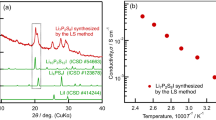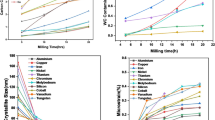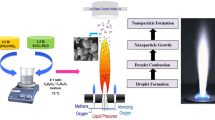Abstract
Bismuth titanate (Bi4Ti3O12) was developed by means of titanium oxide (TiO2) suspension in auto-combustion process at 220 °C to get nanosized (20 ± 5 nm) bismuth titanate (Bi4Ti3O12) powder. Complete piezoelectric phase (tetragonal) was obtained after calcination at 700 °C. Dilatometery of compacts was performed to find out sintering temperature. On the basis of shrinkage results, compacts were sintered at 750, 800, and 850 °C for 2 h. After sintering single phase was obtained with orthorhombic structure analyzed by X-ray diffraction and also investigated by Rietveld method. High-resolution scanning electron microscopy revealed that fine plate-like structure which is a characteristic of BIT powder can be obtained at 850 °C. Sintering results indicate that density and average grain size increase with the increasing temperature. A maximum of about 90 % of the theoretical density was achieved for the sintered product at 850 °C.






Similar content being viewed by others
References
Alexe M, Scott JF, Curran C, Zakharov ND, Hesse D, Pignolet A. Self-patterning nano-electrodes on ferroelectric thin films for gigabit memory applications. Appl Phys Lett. 1998;73(11):1592–4.
Dawley JT, Radspinner R, Zelinski BJJ, Uhlmann DR. Sol–gel derived bismuth titanate thin films with c-axis orientation. J Sol-Gel Sci Technol. 2001;20(1):85–93.
Villegas M, Caballero AC, Moure C, Duran P, Fernandez JF. Low-temperature sintering and electrical properties of chemically W-doped Bi4Ti3O12 ceramics. J Eur Ceram Soc. 1999;19(6):1183–6.
Paz de Araujo CA, Cuchiaro JD, McMillan LD, Scott MC, Scott JF. Fatigue-free ferroelectric capacitors with platinum electrodes. Nature. 1995;374:627–9.
Scott J, Araujo C. Ferroelectric memories. Science. 1989;246:1400–5.
Buhay H, Sinharoy S, Kasner WH, Francombe MH, Lampe DR, Stepke E. Pulsed laser deposition and ferroelectric characterization of bismuth titanate films. Appl Phys Lett. 1991;58:1470–2.
Waqas H, Qureshi AH. Influence of pH on nanosized Mn–Zn ferrite synthesized by sol–gel auto combustion process. J Therm Anal Calorim. 2009;98(2):355–60.
Durrani SK, Qureshi AH, Qayyum S, Arif M. Development of superconducting phases in BSCCO and Ba-BSCCO by sol spray process. J Therm Anal Calorim. 2009;95(1):87–91.
Waqas H, Qureshi AH. A low temperature sintering study of nanosized Mn–Zn ferrites synthesized by sol–gel auto combustion process. J Therm Anal Calorim. 2010;100(2):529–35.
Poth J, Haberkorn R, Beck HP. Combustion-synthesis of SrTiO3, Part II. Sintering behaviour and surface characterization. J Eur Ceram Soc. 2000;20(6):715–23.
Zalga A, Moravec Z, Pinkas J, Kareiva A. On the sol–gel preparation of different tungstates and molybdates. J Therm Anal Calorim. 2011;105:3–11. doi:10.1007/s10973-011-1367-2.
Habibi MH, Mokhtari R. Thermal properties of undoped, S-doped, Nb-doped, and S, Nb co-doped titania nanoparticles prepared by sol–gel method. J Therm Anal Calorim. 2012. doi:10.1007/s10973-012-2563-4.
Bernik S, Daneu N, Recnik A. Inversion boundary induced grain growth in TiO2 or Sb2O3 doped ZnO-based varistor ceramics. J Eur Ceram Soc. 2004;24:3703–8.
McClune WF, editor. Powder diffraction file, inorganic phases. Swarthmore: International Centre for Diffraction Data; 1989.
Young RA, editor. The Rietveld methods. Oxford: IUCR-Oxford University Press; 1995.
Kan Y, Wang P, Li Y, Cheng Y, Yan D. Low-temperature sintering of Bi4Ti3O12 derived from co-precipitation method. Mater Lett. 2002;56:910–4.
Young RA, Wiles DB. Profile shape functions in Rietveld refinements. J Appl Crystallogr. 1995;15:430–8.
Zarycka A, Lisinska-Czekaj A, Czuber J, Orkisz T, Ilczuk J, Czekaj D. The sol–gel synthesis of bismuth titanate electroceramic thin films. Mater Sci Pol. 2005;23(1):167–75.
Kong LB, Ma J, Zhu W, Tan OK. Preparation of Bi4Ti3O12 ceramics via a high-energy ball milling process. Mater Lett. 2001;51:108–14.
Macedo ZS, Ferrari CR, Hernandes AC. Impedance spectroscopy of Bi4Ti3O12 ceramic produced by self-propagating high-temperature synthesis technique. J Eur Ceram Soc. 2004;24:2567–74.
Author information
Authors and Affiliations
Corresponding author
Rights and permissions
About this article
Cite this article
Naz, S., Durrani, S.K., Qureshi, A.H. et al. Nanosized bismuth titanate (Bi4Ti3O12) system drive through auto-combustion process by using suspension titania (TiO2). J Therm Anal Calorim 114, 719–723 (2013). https://doi.org/10.1007/s10973-013-3029-z
Received:
Accepted:
Published:
Issue Date:
DOI: https://doi.org/10.1007/s10973-013-3029-z




